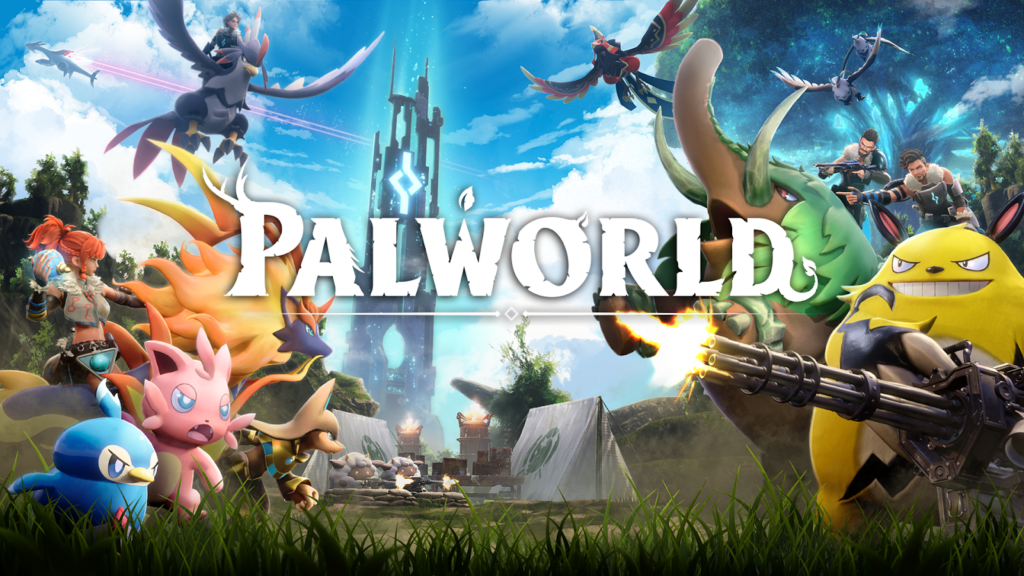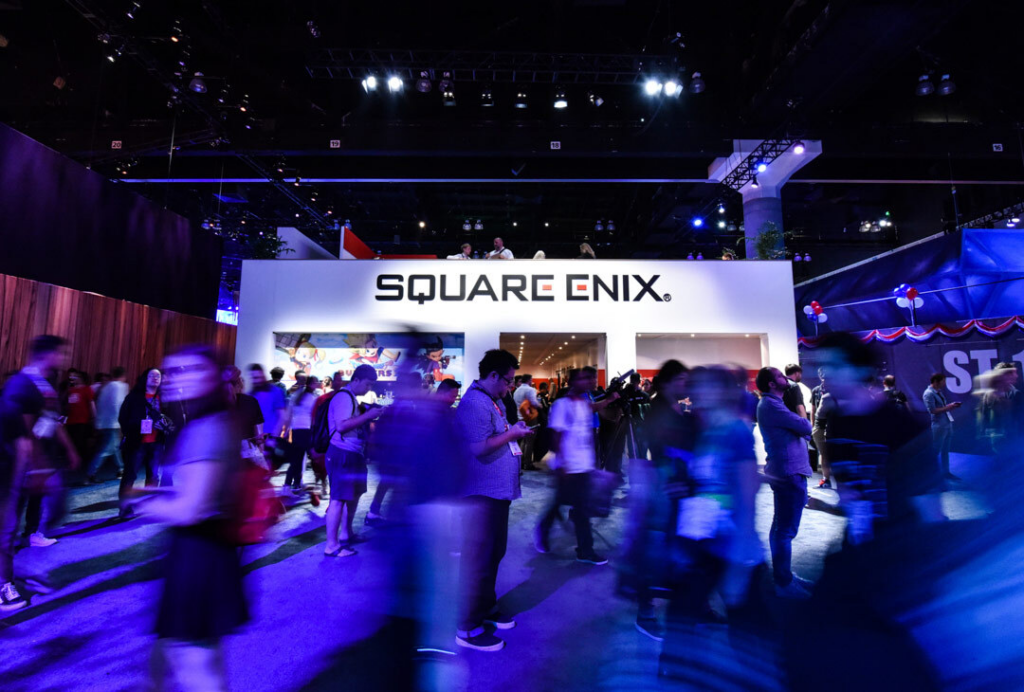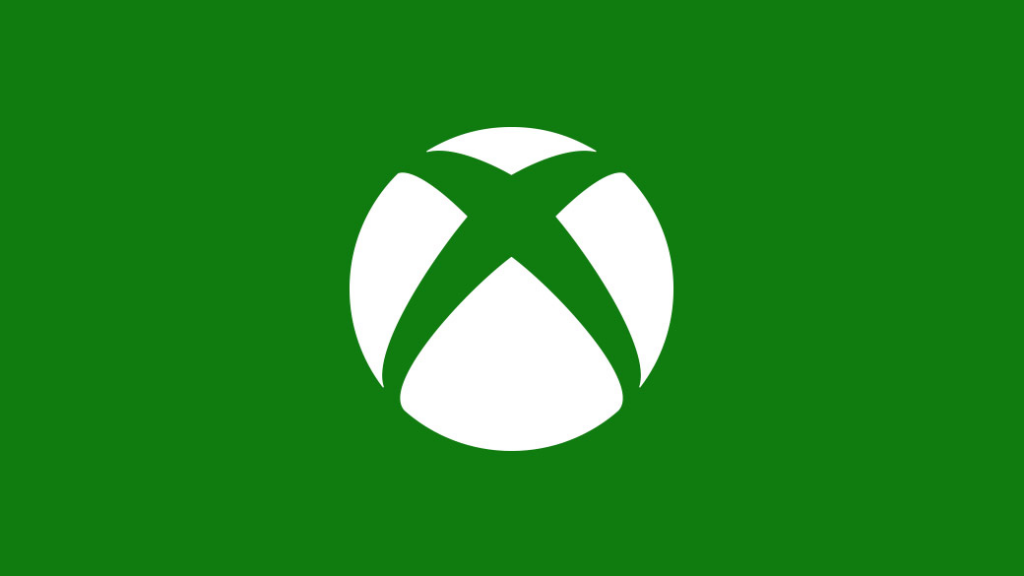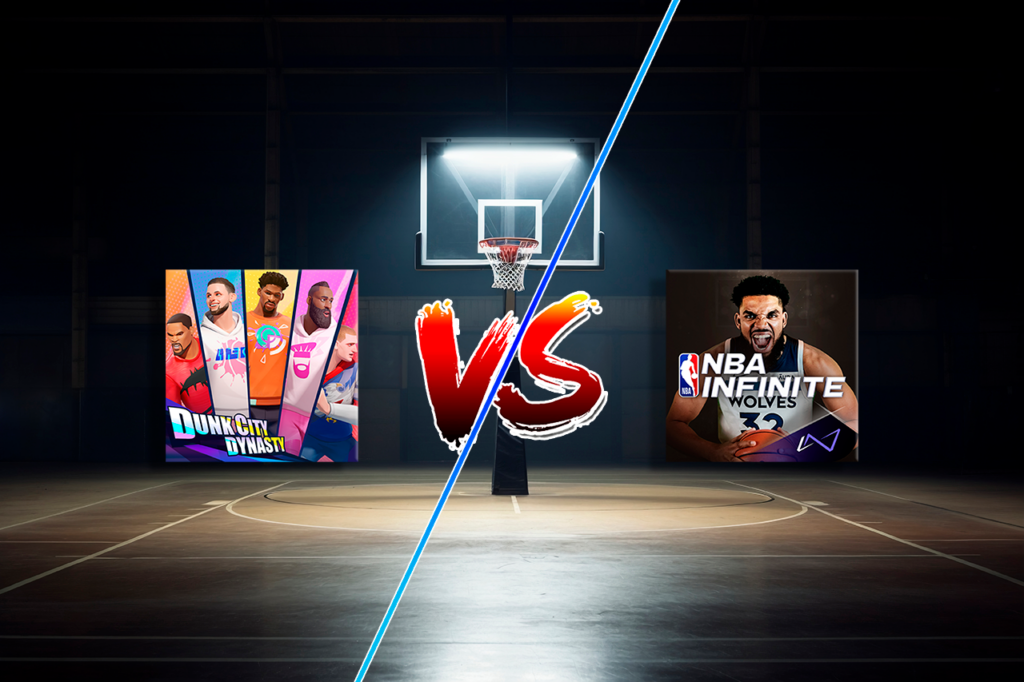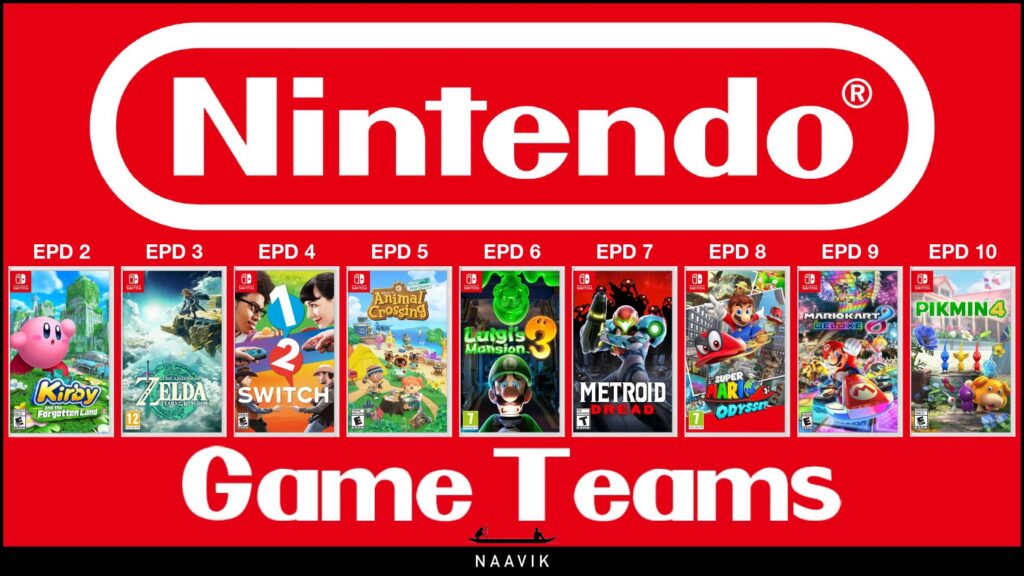
Mario Kart, Mario Party, Super Mario Bros. Wonder, Paper Mario, and Super Mario Odyssey are all parts of the same franchise, but they were each developed by distinct teams within Nintendo’s Entertainment Planning & Development (EPD) group.
Following a 2015 organizational revamp led by General Manager Shinya Takahashi, Nintendo established ten separate EPD teams. Each of them has their own managers, producers, and project leads working on specific series and focuses, utilizing the division's talent pool for each project. Developers frequently transition among these teams, but the roles of managers, producers, and directors for every EPD outfit remains fixed.
Before discussing each team's role, it's important to note that the 2015 restructure was Nintendo's second major overhaul. For two decades, Nintendo had four R&D departments, with R&D4, introduced in 1984 and led by Shigeru Miyamoto, being responsible for most internal game development. R&D4 was later renamed Entertainment Analysis & Development (EAD).
In 2004, under President Satoru Iwata, the first restructure transformed Miyamoto’s EAD team into eight groups (EAD 1-8) handling most internal development. Additionally, two departments oversaw hardware: Research & Engineering Development (RED) for handhelds and Integrated Research & Development (IRD) for consoles. A new division, Software Planning & Development (SPD), focused on smaller titles and supervised external first-party development.
The 2015 restructure, following Iwata’s death, unified all hardware development under the new Platform Technology Department (PTD) and merged EAD and SPD into a single Entertainment Planning & Development (EPD) department, ending the legendary Miyamoto-led division after 26 years. In hindsight, this restructuring does make sense since the Switch essentially blended their console and handheld businesses into one. Therefore, merging their handheld RED and console IRD hardware departments into PTD makes sense, and so does merging EAD and SPD into EPD.
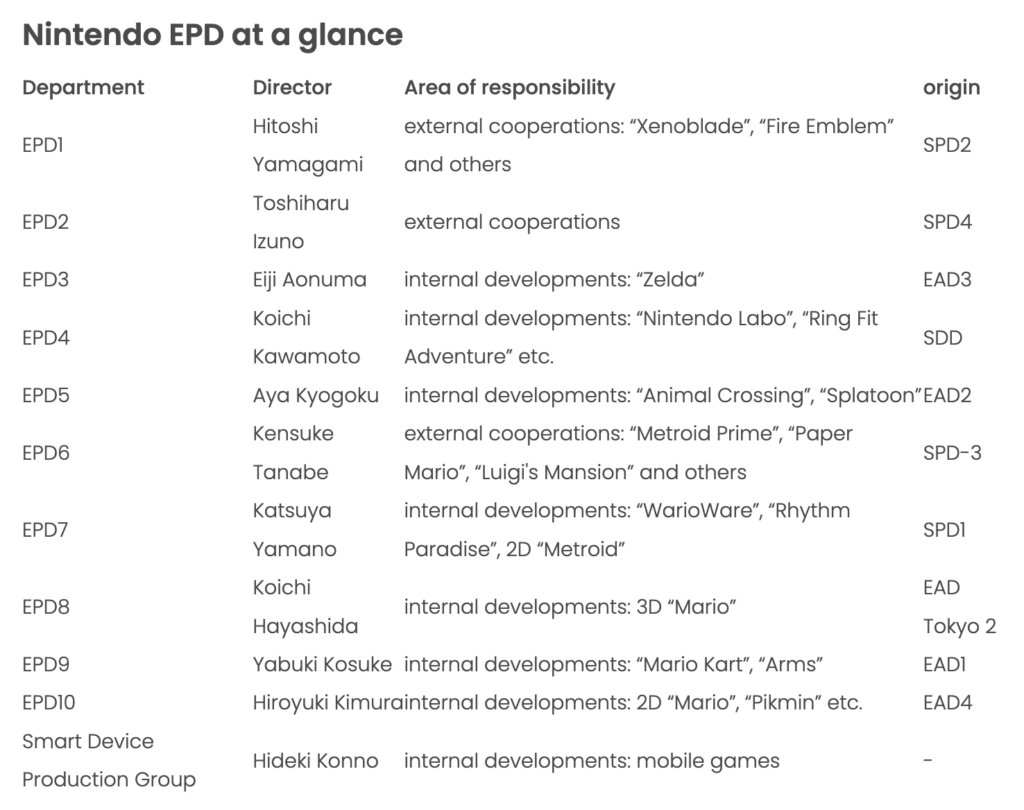
Now, let’s dive deeper into the various EPD teams and uncover more about the masterminds behind some of the bestselling Nintendo games.
The Teams Behind the Games We Love
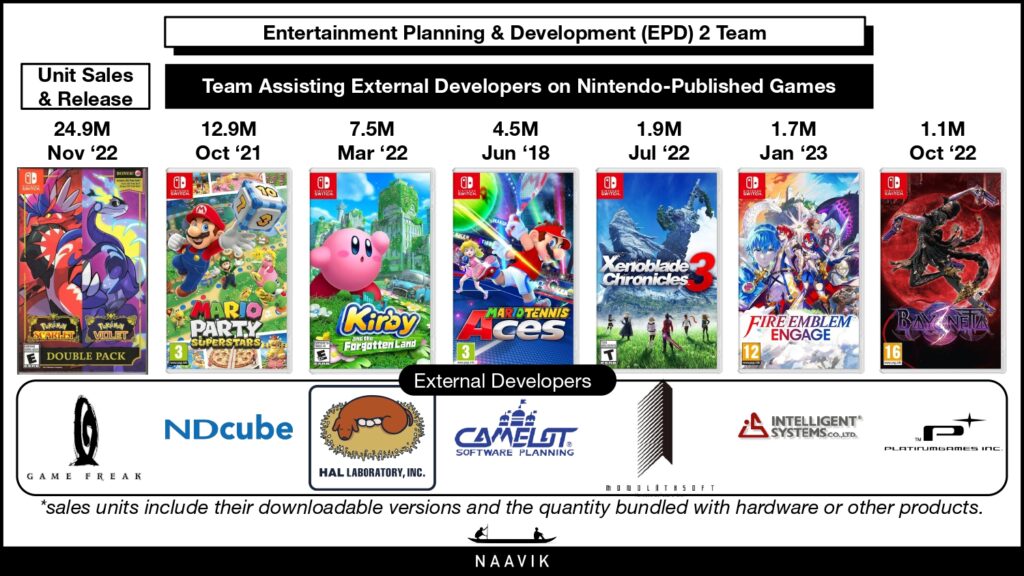
Out of the nine EPD teams, three (EPD 2, 6 and 7) exclusively collaborate with external developers on Nintendo-published titles, with EPD 2 the largest of the trio since the integration of EPD 1 into EPD 2 in 2019. Since then, EPD 2 has supported the development of major series such as the Pokémon games by Game Freak, Fire Emblem games by Intelligent Systems, and the Kirby games by HAL Laboratory, to name a few. The development of Mario’s sports, RPG, and party spinoff games is also managed by EPD 2.
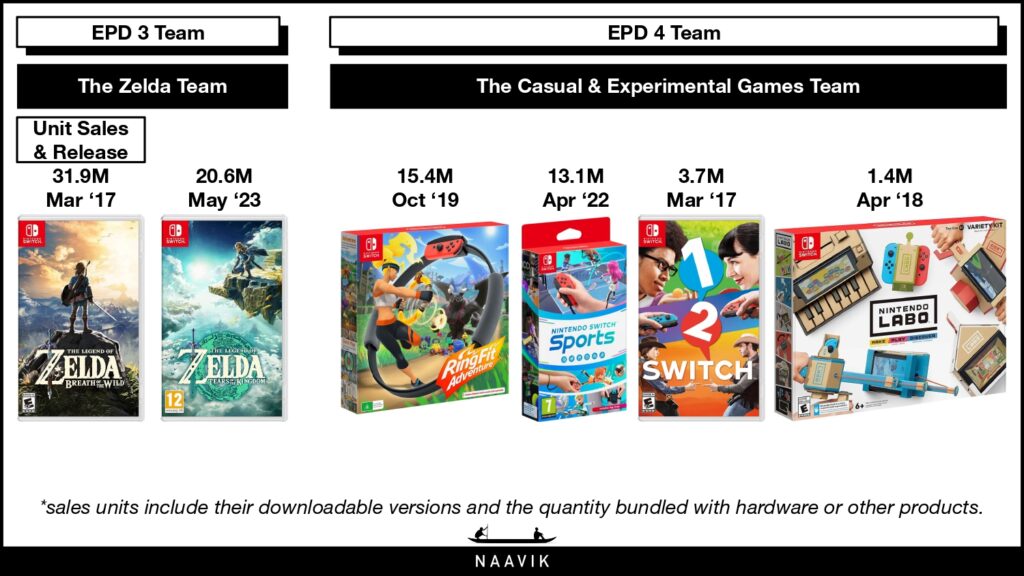
EPD 3 is the core Zelda team that developed both Breath of the Wild and Tears of the Kingdom. It also supports the external development of spinoff or rereleased Zelda titles like Hyrule Warriors by Omega Force and Skyward Sword HD by Tantalus Media. Moving forward, it‘ll focus on the internal development of the next open-world Zelda game, and continue to support spinoffs and remakes made by external partners.
EPD 4 is home to the creative minds behind the iconic Wii series: Wii Sports, Wii Play, Wii Fit, Wii Party, and Wii Music. These titles, known for their pioneering control systems and casual gameplay, played a pivotal role in broadening Nintendo’s audience, captivating a diverse group of players with their innovative design and mass appeal. Its recent work ranges from the cardboard toys-to-life platform Nintendo Labo to exercise game Ring Fit Adventure – a breakout hit with over 15M copies sold.
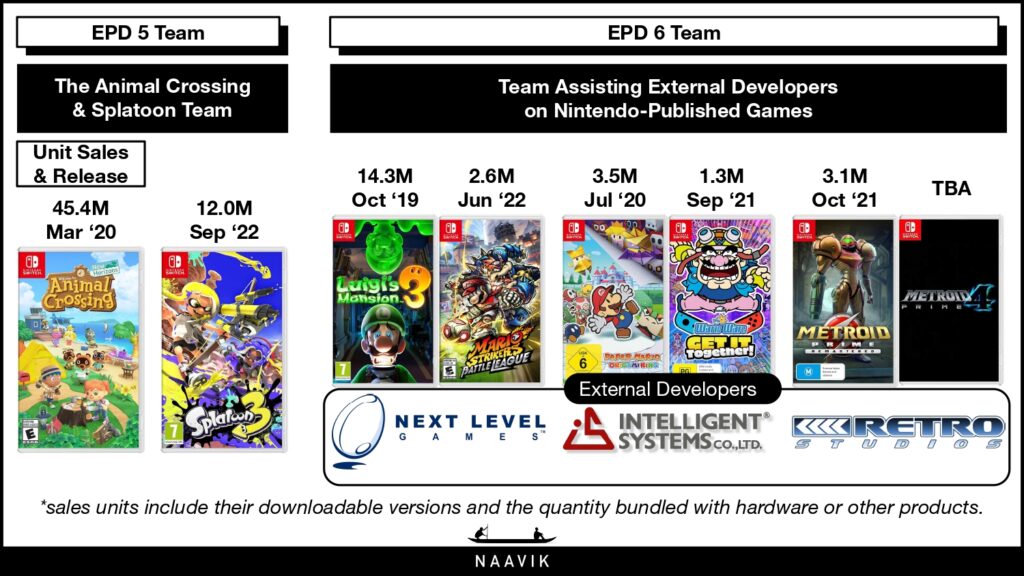
The Animal Crossing series also has its roots in the casual, experimental EPD 4 team. This unit was later separated to form EPD 5, now responsible for the Animal Crossing and Splatoon franchises. While Animal Crossing caters to a wider audience with its casual gameplay, Splatoon reflects the team’s experimental nature with Nintendo’s unique take on the team shooter.
EPD 6 is a support team for Nintendo IP games developed by external teams, like Luigi’s Mansion by Next Level Games, Intelligent Systems’ Paper Mario games and 3D Metroid games from Retro Studios. In contrast to EPD 2, the external development partners associated with EPD 6 exclusively develop games published by Nintendo.
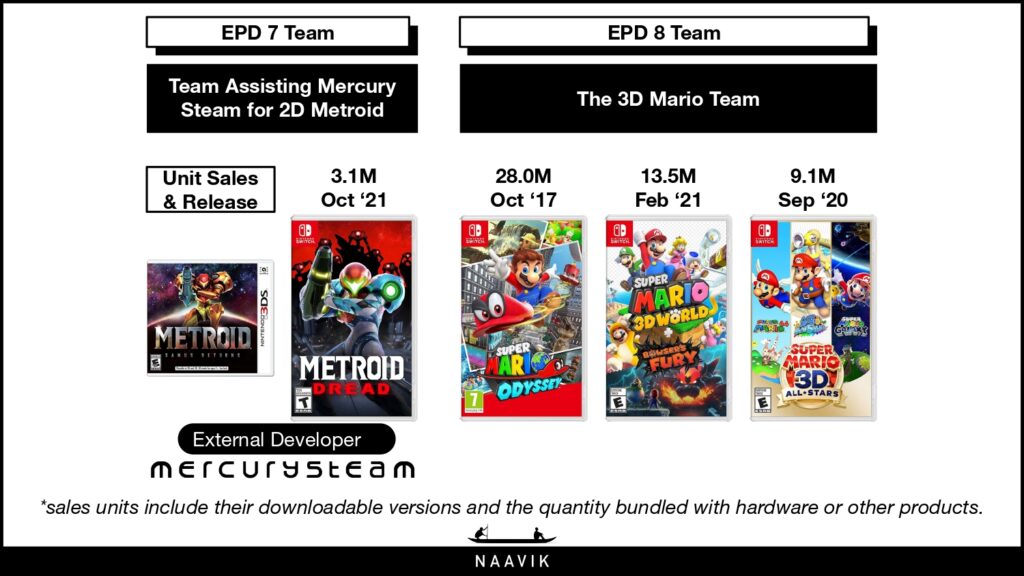
EPD 7 is the home of 2D Metroid games, a series now solely co-developed with external partner Mercury Steam. Distinguishing between 3D and 2D titles within the same series like this is also a strategy employed for the Mario franchise.
Which brings us to EPD 8, the team behind the 3D Mario games. It is responsible for two 3D Mario games that have made it into Metacritic’s top five Best Games of All Time – Super Mario Galaxy 1 & 2. It is also the creator of Super Mario Odyssey, 3D World, and remasters 3D All-Stars, all hailed as some of Nintendo’s most innovative and fun-filled games.
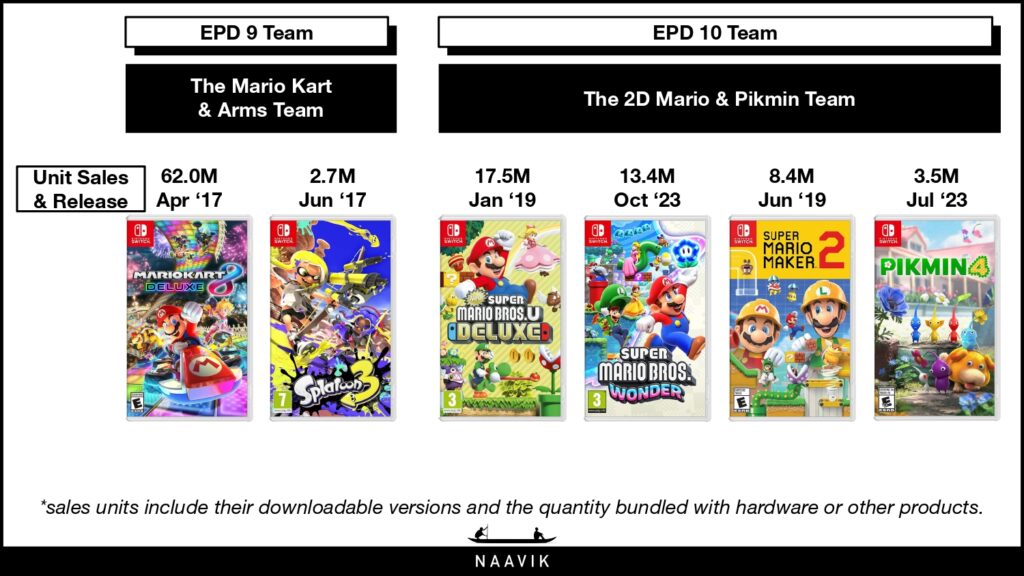
Nintendo’s EPD 9 division holds the accolade for creating the top-selling Nintendo Switch game, Mario Kart 8 Deluxe, with 61.97M copies sold. It is responsible for the Mario Kart franchise, which is also primed for a new instalment – Mario Kart 8 originally came out a decade ago for the Wii U. Additionally, EPD 9 is notable for introducing the last new IP from Nintendo, Arms. Despite its initial buzz, Arms did not gather enough momentum to become a lasting franchise.
EPD 10 holds talent responsible for the 2D Super Mario Bros. games and oversees the development of the Pikmin franchise. Last year was notable for the team with the release of both Super Mario Bros. Wonder and Pikmin 4.
A quick note on the Smart Device Production Group, commonly referred to as EPD Mobile: it is a team dedicated to bringing Nintendo’s IP to mobile with the assistance of external studios, alongside other EPD groups that manage those IP. At the helm of EPD Mobile is Hideki Konno, a veteran at Nintendo with a tenure of 37 years, who holds the title of Producer for all of Nintendo’s mobile games. The structure of EPD Mobile is somewhat ambiguous; it is not certain if they function as an autonomous unit known as EPD 11 or parts of different EPD teams picked for their expertise in their respective franchise. But what’s clear is that while Nintendo does not heavily focus on mobile internally, it acknowledges mobile’s significance and does not entirely disregard it.
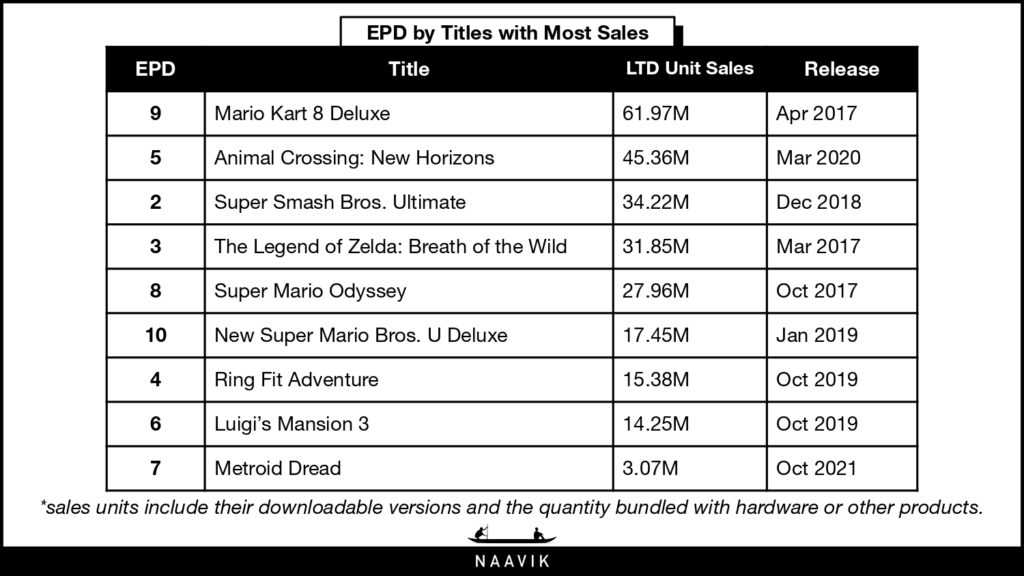
Looking at the numbers, each of the EPD teams have had remarkable critical and commercial success. Eight of the nine EPD teams have released at least one game surpassing 14M unit sales on Switch, and the leading four EPD teams boast titles with sales exceeding 30M units. EPD 7, the team behind the 2D Metroid series, comes in last – but it has also enjoyed respectable success with Metroid Dread sales surpassing 3M.
The Minds Behind Nintendo’s EPD Teams
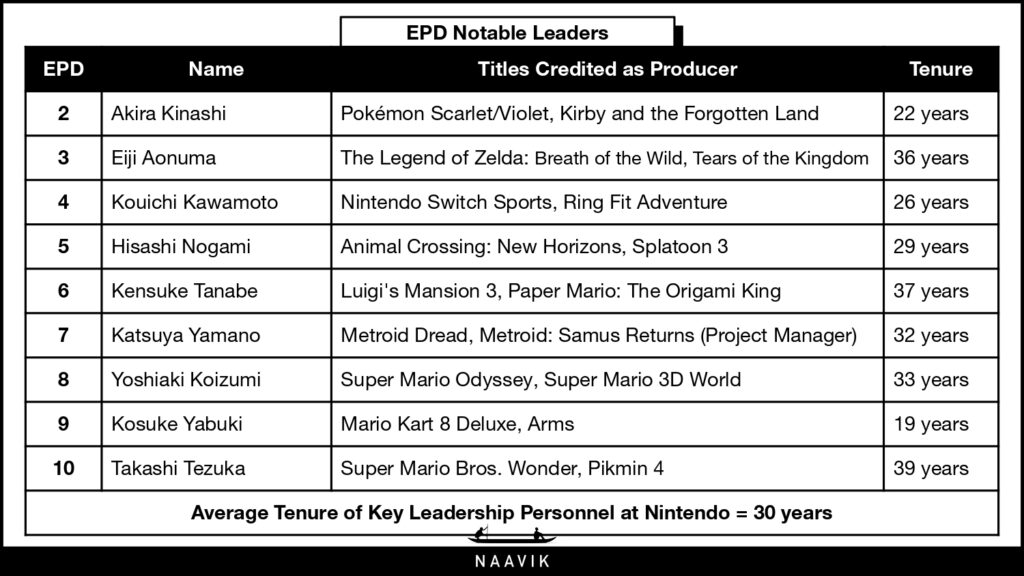
At Nintendo, the employee retention rate is remarkably high, with approximately 99% of new hires choosing to stay with the company. And as seen in the image above, the average tenure of an EPD leader is 30 years! In 2014, Nintendo’s leadership team made headlines for reducing their own salaries to prevent employee layoffs. This decision, rooted in a strong belief in their workforce’s talent and ability, catalyzed a remarkable financial recovery.
When Shuntaro Furukawa, the current president of Nintendo, was asked about Nintendo’s long-term development strategy in a recent earnings call, he had this to say:
“We will continue to actively work to secure the necessary development resources to increase the long-term value of our IP and to constantly offer unique entertainment proposals. Although development resources could be expanded through M&A, first we will work within the company with our developers, who thoroughly understand and have built up the Nintendo brand over the years, to have them nurture talent who can drive Nintendo's future development.”
This highlights a significant advantage of the EPD team structure: brand mastery, specifically, mastery over game genres by each team. For instance, when the 2D Mario team released Super Mario Bros. Wonder in October 2023, a full 38 years after the original Super Mario Bros., the five developers from the first game were present in the credits for Wonder. This is a testament to the team’s dedication and expertise in developing the 2D Mario franchise.
This mastery also translates into sales – each of the teams, working on different brands and genres, have released a Switch game that is also their highest selling title to date. Moreover, the top ten best-selling Switch games are all published by Nintendo, which means the EPD department has had a hand in all of the most successful Switch titles.
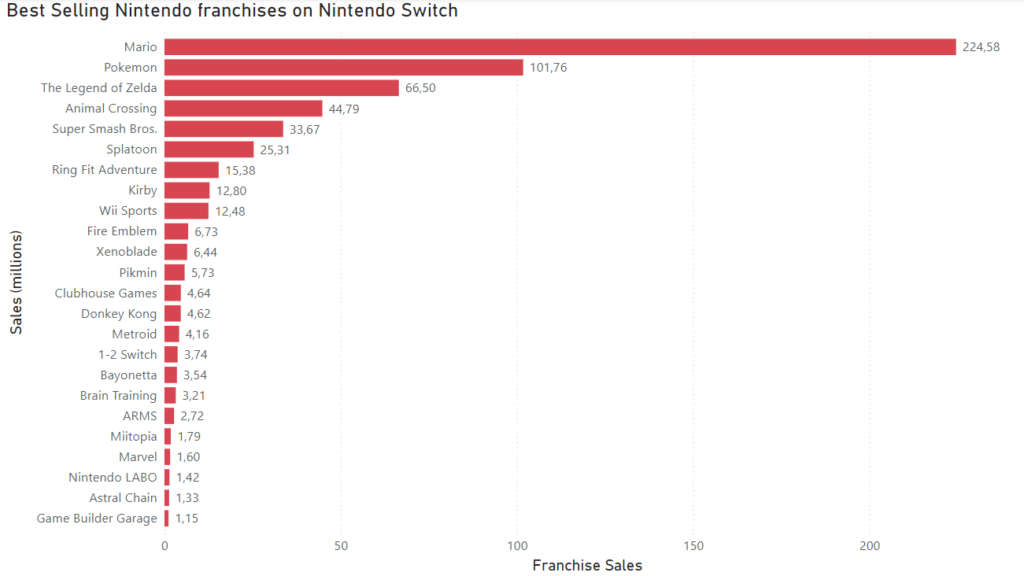
Given this scale, the EPD department is relatively small with the last reported estimate of 800 employees. Not only does that average out to 80 employees per EPD team, but also equates to ~10% of Nintendo’s last reported total employee count (~7,300). In comparison, Activision Blizzard last reported that just the Call of Duty franchise had 3,000 people working on it, and lifetime franchise sales seem to be pegged at ~500 million units. Similarly, it is reported that GTA V took a ~1,000 person team to build, and lifetime franchise sales also seem to be pegged at ~500 million units. The Mario franchise is reported to have its lifetime unit sales north of 800 million units. Of course, the Mario franchise has had way more time on the planet than both CoD and GTA, which makes a direct comparison of the above numbers not entirely fair. But today’s size of the EPD division versus the business success it sees still does showcase a stark revenue efficiency difference to how most major developers build, grow, and staff major franchises today. In other words, Nintendo has clearly found a way to make its small EPD team size work to its advantage.
Development at Nintendo takes time, though, and contributes to what some might consider extended production cycles. For instance, the Zelda team, EPD 3, took over six years to create Tears of the Kingdom, which was mostly built on its predecessor, Breath of the Wild. Despite this, the sequel took one year more to develop than the original game. Similarly, the 2D Mario team, EPD 10, had not released an entirely new title for a decade prior to the launch of Super Mario Bros. Wonder. This development philosophy – ‘good things take time, and great things take a bit more,’ – might also be why Nintendo’s game teams have not yet shifted to producing live service games, since they demand the regular and timely supply of fresh content. This is a risk in an environment where more and more players are spending time in live service games.
Speculating on a couple more advantages of the EPD team structure — first, it seems more decentralized compared to the previous EAD setup, where Miyamoto might have influenced the product vision across multiple titles. The benefit of this decentralization is evident in the recent ground-up reimaginings of traditional IPs like Mario and Zelda to continue to keep them fresh for an ever-evolving audience. Second, even though the EPDs might seem siloed, there is likely more talent movement and knowledge sharing between them than is apparent from the outside. This is demonstrated by how various Mario franchise titles are developed across multiple EPDs, and how an open world sports title like Ring Fit Adventure involved developers from the Zelda team. These developers used their technology and assets to populate the open world, resulting in a common visual style between the two distinct titles.
It’s hard to criticise Nintendo for consistently delivering high-quality, top-selling games for its dedicated platform made by these distinct, specialized EPD teams. The current Nintendo Switch generation has surpassed the financial success of any prior generations – even the DS and Wii era – and is more profitable now than in its last 35 years combined. We’re confident Nintendo’s EPD team structure will continue to pave the way for success at the company well into its second century.
A Word from Our Sponsor: LIGHTSPEED
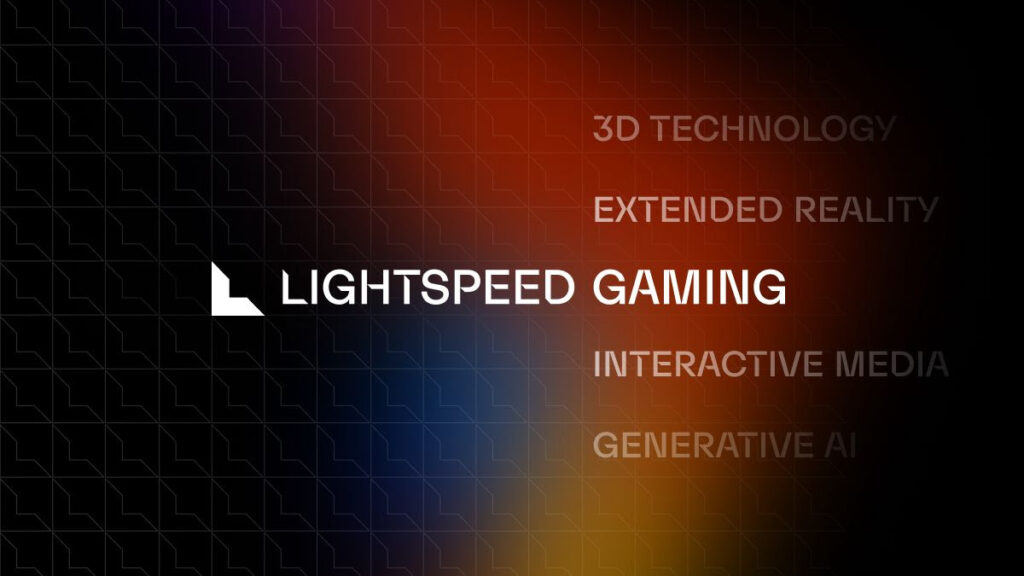
Partnering with Extraordinary Founders in Gaming & Interactive Media
Lightspeed is a globally leading venture capital firm across the US, Europe, and Asia with over $29B under management. Over the past 20 years, Lightspeed has partnered with hundreds of exceptional entrepreneurs and helped build companies to achieve 200+ IPOs and acquisitions.
With its dedicated gaming practice, Lightspeed Gaming, the firm invests from an over $6.5B pool of early and growth-stage capital — by far the largest set of funds in the sector. Lightspeed's team combines deep gaming, consumer, and enterprise technology expertise with a global multistage investment platform and a culture that truly puts founders first.
Focus areas are game studios (PC, console, mobile), interactive media platforms (social, UGC, distribution, streaming), and related technologies (AI/ML, 3D, engines, game development, AR/VR).
Selected investments include Epic Games, Inworld AI, Gardens, and The Believer Company — as well as designers and producers who led the creation of titles like Fortnite, Call of Duty, League of Legends, Wild Rift, Apex Legends, Overwatch, Valorant, StarCraft II, and Warcraft III.
In Other News
💸 Funding & Acquisitions:
- Private equity firm in talks to buy Keywords Studios
- Atari acquires Intellivision brand and over 200 games
- IGN Entertainment acquires Eurogamer, GI, VG247, Rock Paper Shotgun and more
- Nintendo acquires Switch port specialist Shiver Entertainment from Embracer
- Plarium and Big Fish up for sale at Aristocrat
- Sinn Studio raises $2.5M for real-time PvP VR combat game
- Anomaly raises $1.45M for AI-driven Layer 3 gaming platform
- Moonton not for sale as Bytedance stays in the game with new CEO
📊 Business & Products:
- Report: Sony planning mobile games platform
- Doubts linger over Xbox app store as July launch looms large
- Mattel and Outright Games partner on 3 console and PC games
- Embracer Group full-year sales rise to $3.9bn, but $1.5bn debt remains
- Sega reaches financial targets one full year ahead of schedule in record fiscal year
- Bandai Namco reports record sales and rise in profits despite video game decline
- Amazon Games expands European presence with new game studio in Bucharest
👾 Miscellaneous:
- Microsoft to add next Call of Duty to Xbox Game Pass, WSJ reports
- Microsoft Is Putting Its Copilot AI Into Games Like Minecraft
- Inworld AI launches Inworld Voice to generate game character voices
- With Squad Busters imminent, Supercell is already teasing its next potential launch: Mo.co
- New Elden Ring Shadow of the Erdtree Trailer Gives Story Fans Plenty to Chew Over


